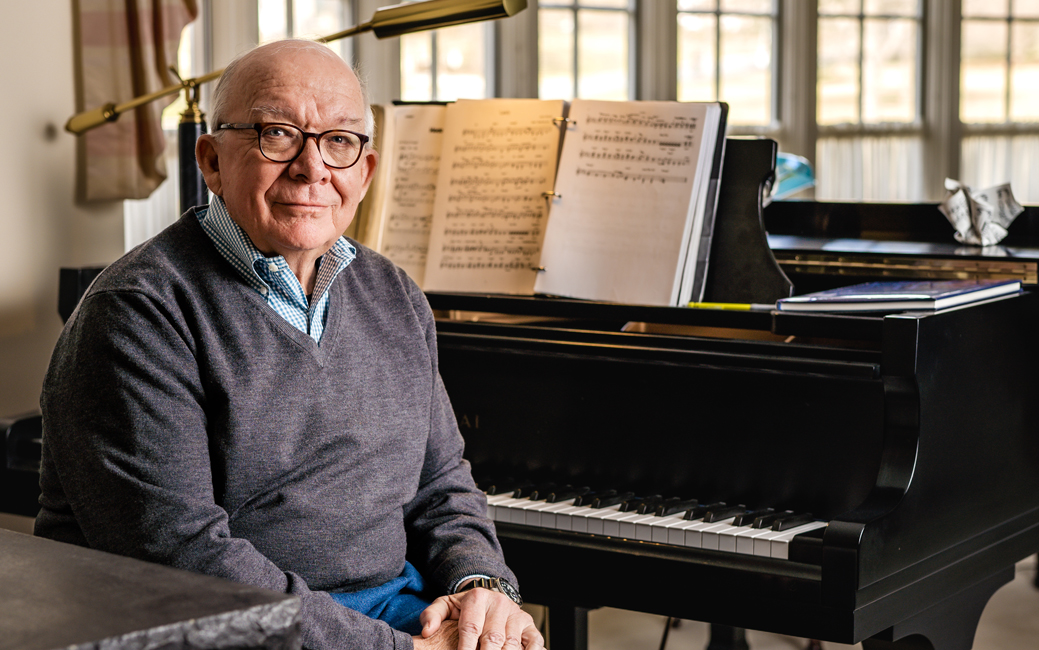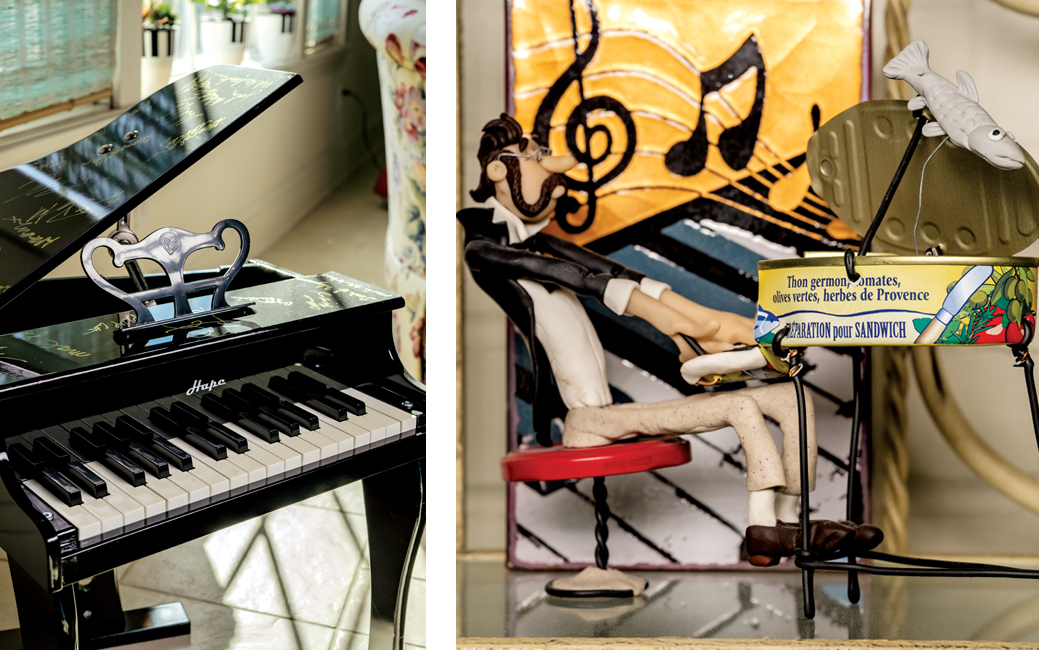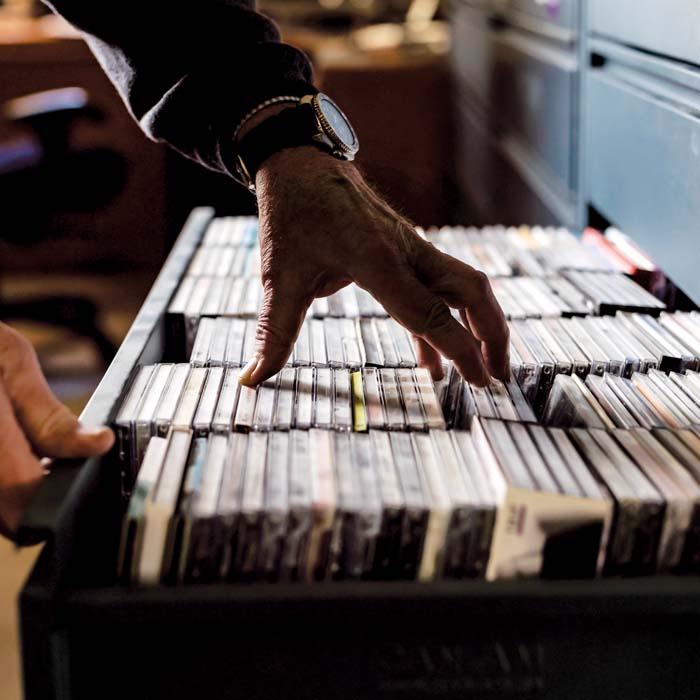All That Jazz
Bill Murray ’08, ’11 might have gotten a late start making music, but that doesn't mean he’s stopping anytime soon.
By Mike Unger
Photos by Nick Sibol ’23

At first, the tune is so faint you think it may be playing just in your mind. But
as you walk from the dimly lit parking garage into the hallway of Greater Baltimore
Medical Center (GBMC) in Towson, past one sign warning those with COVID-19 symptoms
not to enter and another proclaiming “Heroes Work Here,” the jazzy notes become progressively
louder. A few steps later, you arrive at the lobby outside the emergency room, where
the man who’s making this music in the most surprising of venues sits at an old brown
Baldwin grand piano, his fingers deftly tapping away.
Bill Murray ’08, ’11 is perched on a black cushion atop the worn maroon one that covers the bench. As doctors, nurses, support staff, patients and visitors shuffle by, he continues to play. Occasionally EMTs pass pushing a person on a stretcher, and still, Murray plays. Everyone is wearing a mask, so it’s tough to tell when a few moments of a song elicit a warm feeling or smile—however fleeting—from a listener.
But you can tell.
Most people don’t stop, but one man is sitting in a wheelchair, intently watching and listening as Murray plays “Polka Dots and Moonbeams,” a popular jazz standard from the 1940s.
“That’s beautiful,” he says after Murray finishes.
“Any favorites?” Murray, 78, responds.
“I’ll let you select them,” says the man, who’s hooked up to an oxygen tank. “I really enjoy the way that you play.”
The man stays for only a few more minutes before he’s wheeled to treatment. He’s here five days a week for radiation. Murray’s music, he says, is the best part of his day.
“I try to play relaxing music, mostly ballads and medium tempo songs,” Murray says. “I am a great believer in the concept of music therapy. Most of these people don’t want to be here. If I give them 15 or 30 seconds of relaxation, I’m happy. It’s a great experience for me.”
Murray began volunteering at GBMC nearly a decade ago, when his late wife, Helen, was being treated there for cancer. He noticed an old piano sitting dormant, collecting dust, and asked if he could use it. He’s been playing it twice a week ever since.
Few people love anything more than Bill Murray loves jazz, and few people are as invested in seeing its next generation of performers thrive. His establishment of and support for the Murray Fund for Visiting Jazz Artists and the Murray Jazz Residency have positioned TU as a leader in the field—and he’s not done giving. Last year Murray pledged $545,000 to RISE, the campaign for Towson University. The money will support the TU Foundation Grant Endowment, subsidize College of Fine Arts and Communication performance student tickets and fund the programs that bear his family name. He also plans to donate his immense collection of jazz CDs, books and vinyl to TU’s Special Collections and University Archives.
Murray’s relationship with TU is part of what he calls his second journey in life. After a successful career in commercial banking, he pivoted at the age of 58 and decided to turn his passion for jazz into an academic pursuit. Two degrees, five albums, 50 original compositions and countless acts of philanthropy later, he’s created a legacy that will ensure his impact on the genre will be felt for years to come.

The Colorado town in which Murray grew up was not exactly the cultural equivalent of Greenwich Village. Located about 150 miles south of Denver, Walsenburg had only about 5,000 residents, few of whom likely saw Duke Ellington or Charles Mingus perform.
But music was always flowing through the Murray household. Bill’s mother, Virginia, was a singer and a music teacher. She died when he was 9, but the love for the art form she instilled in him resonated. When he was in middle school, his buddy formed a band and asked Murray to be the piano player.
“The songs were jazz, from the Great American Songbook,” he says. “It was a little before rock and roll started to come in. We’d play homecomings and proms. I played my first New Year’s Eve gig for adults when I was in the eighth grade. I was making $10 a night. I thought I was in heaven.”
Murray played trombone in the marching band in high school, and when he arrived at the University of Colorado as an undergraduate, he joined the Golden Buffalo Marching Band.
After graduating with a degree in business, he earned an MBA from Northwestern University and went to work for Illinois National Bank. He met Helen in Chicago, and the two were married in 1970. The couple moved to suburban Glen Ellyn, where Murray announced to his wife that he was buying himself a Christmas present: a piano.
In 1982, Murray got a job with a bank in Maryland, and the family moved to the single-family home in Towson in which he still lives. Shortly after relocating, he started exploring Baltimore’s jazz clubs.
“I was determined to find a person that I could take piano lessons from,” he says. “This was my main hobby. I wanted to learn how to play jazz piano.”
At a club near the old Mechanic Theatre on Charles Street downtown, Murray met a piano player named Lou Rainone, who would become his teacher for the next 20 years. While playing remained a passion, it took second billing to his banking career and helping to raise his three children. But when the kids left the nest and his bank was sold, Murray leapt at the chance to retune his life.
“I never used the word retirement,” he says. “You’ll never hear me use that word. I just don’t like it. I use the term ‘second journey.’”
His first call was to Terry Ewell, a professor in TU’s music department, who spoke to him about the university’s program. In 2002, he became a 58-year-old freshman.
“What I noticed is he’s a very humble gentleman,” says Ewell, a bassoonist who teaches online technology and music theory. “Very eager to learn and very interested in improving his musical skills. When he came into the music department, he didn’t expect any special favors. He just wanted to be like one of the students. The jazz faculty were very pleased to have him there. He was an eager student and applied himself diligently.”
Despite being four decades older than some of his classmates, Murray was determined to assimilate.
“When I was working, I said, ‘I don’t ever want to be called Mr. Murray,’” he says, laughing—as he frequently does. “When I was working with younger people, I wanted them to feel like they could call me Bill. So I made it known right away that I was Bill. I’d sit in the back of the class and keep my mouth shut. I would tell the professors. ‘Don’t expect me to raise my hand. If you call on me, I will respond, but I don’t want to take anything away from the other students.’”
Six years after enrolling, Murray owned a second bachelor’s degree, this one in music. But he wasn’t done. Thirsting for more knowledge and playing experience, he went on to earn a master’s in music three years later. His thesis compared the work of his idols, jazz pianists Bill Evans and Billy Strayhorn, with his own compositions.
During his second scholastic stint, Murray decided to establish the Murray Fund for Visiting Jazz Artists. Three years later, he and his wife founded the Bill and Helen Murray Jazz Residency, which the fund for visiting jazz artists now supports. (It’s now known as the Murray Jazz Residency, and his sister and children also are donors.)
Each term TU hosts a jazz professional who, over the course of a week, gives private lessons to students, teaches a master class and performs one concert with their peers and one with TU students.
“It’s definitely distinguished us from other jazz programs in the nation,” says music professor Dave Ballou, leader of the Jazz and Commercial Music Division and founding director of the Murray Jazz Residency. “Other programs bring in great people for a few days, and mostly those programs only have the guests play with the faculty, but we insist on the guests playing with the students. It’s had such a profound effect on the students.”
A decorative address plate in the shape of a piano outside Murray’s home offers guests a preview of what awaits when they enter. Much of the decor in the house could be described as piano chic—if that actually was a thing. The focal point of the front living room is the 35-year-old Kawai grand piano he plays almost every day. On it sits a tip jar, a tongue-in-cheek gift from his family that came with a few dollar bills in it. (They’re still stuffed in there.)
Down a flight of stairs is a den lined with bookshelves. He estimates he has more than 3,000 volumes on jazz and classical music, most of which he’s read. Up another flight of stairs is his recording studio, where he spends many of his waking hours at home. It’s packed with file cabinets containing most of his roughly 10,000 jazz CDs, which he believes is one of the biggest collections in the world. The rest are in the basement—he ran out of room upstairs.

There are two electric pianos and a computer for when he wants to compose, but he spends most of his time in the studio listening to music. While the tunes flow through his world-class Totem speakers he often works on Japanese number puzzles or builds Lego sets that his kids give him. This Christmas, he got a 1,600-piece jazz quartet set that, for now, remains unopened.
Sprinkled throughout the room are photos of Murray with jazz luminaries whose camps he’s attended. The drummer T.S. Monk. Saxophonist Ravi Coltrane. The late, legendary tenor sax player Stanley Turrentine.
Also displayed are Murray’s albums, which he hands out for free to friends and family. He recorded many of them with TU faculty and alums. Billy’s Touch, a soothing, melodic collection of seven Murray originals, features Murray on piano, TU adjunct professor Jeff Reed ’02 on bass, Frank Russo on drums, Dan Ryan ’13 on guitar, and Ballou on trumpet.
“He has a very strong idea and opinion about what he wants musically, but it’s great to work with him because he doesn’t assume that he knows everything. He’s very self-effacing,” Ballou says. “Jazz and improvised music are very personal expressions. It’s an art form. What I like about Bill is that he’s somebody who is using that art form to express what he wants to express in it. That’s cool.”
In the back of the house is a second living room, which is dominated by Murray’s collection of tiny, kitschy pianos he’s bought and been gifted from around the world. There are hundreds of them. One is a small rendition of a piano that’s actually a wine bottle holder. Another is a figurine playing a piano crafted from a tuna can. He got that one in the Bordeaux region of France.
Murray is proud of his philanthropic efforts at TU and keeps several plaques and awards from the university on display in the room. He joined the Towson University Foundation board in 2006 and served as the organization’s president from 2018 until he stepped away in 2022. There’s another, slightly larger model piano that sits on the floor near the door that was a gift from TU to commemorate the 10th anniversary of the Murray Jazz Residency.
When he founded the program, it was named for Murray and his wife. The two were inseparable for decades until she died from colon cancer in 2013. In one corner of the room sits a framed copy of his original score for “Thinking About You,” his love song to his bride.
“She went through seven years of cancer and treatment and ups and downs,” he says. “It blew my life apart, but in the last couple of years of her life, we knew that it was not a question of if, it was a question of when.”
After a grieving period, he met Rodica Johnson. She was a fellow volunteer at GBMC, and the two have become friends and enjoy spending time together. Now that the pandemic has subsided, they’re looking forward to resuming traveling as well. Murray also is planning to record two more albums in the near future.
“It’s been an interesting life,” he says with the curiosity of a man wondering where his next journey—and note—will take him.
